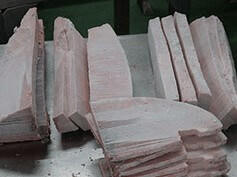 In order to maintain the quality of tuna, when it is caught in the sea, the ikejime technique is used first, then rapid freezing is used as a matter of course. This means that the quality of the thawing technique is also important. Poor thawing conditions mean that the drip outflow volume will be too high, shrinking the meat and worsening the texture. Here I will explain a thawing method that doesn’t cause drip, uneven thawing, or loss of color.
In order to maintain the quality of tuna, when it is caught in the sea, the ikejime technique is used first, then rapid freezing is used as a matter of course. This means that the quality of the thawing technique is also important. Poor thawing conditions mean that the drip outflow volume will be too high, shrinking the meat and worsening the texture. Here I will explain a thawing method that doesn’t cause drip, uneven thawing, or loss of color.
What exactly is drip anyway?
 I’m sure you’ve seen it before in any type of thawing frozen meat, but there is a red liquid that comes out of the tuna when thawing. This is called ‘drip’. This liquid includes the tuna’s umami, and when the fish loses a lot, it naturally detracts from the flavor.
I’m sure you’ve seen it before in any type of thawing frozen meat, but there is a red liquid that comes out of the tuna when thawing. This is called ‘drip’. This liquid includes the tuna’s umami, and when the fish loses a lot, it naturally detracts from the flavor.
First of all, we will explain the worst thawing methods. Never thaw naturally at room temperature or in the microwave. These are common methods at home, but they are out of the question.
Next we will explain the general method of thawing.
- Mix 30 g of salt with 1000 cc of warm water at 40℃ to create a saltwater mixture.
- Place the frozen block of tuna in this 40℃ saltwater, submerge for one to two minutes and then drain the water.
- Wash any remaining salt off the surface of the block of fish with fresh water and remove moisture from the surface with paper towels.
- Wrap the fish in clean paper towels, wrap with plastic over that and leave it in the refrigerator for about a day to thaw naturally.
- Cut from the block directly before consuming.
Now for the thawing method used by professionals, such as sushi chefs.
The first three steps are the same as the general thawing method above.
- Place block in an air-tight plastic bag. Push out as much air as possible before sealing the bag.
- Prepare ice water in a bowl or container and submerge the plastic bag in the water for one hour. Normally the bag will float, so it must be weighed down with something.
- Remove the thawed tuna from the plastic bag and remove moisture with paper towels.
- Wrap the fish in clean paper towels, wrap with plastic over that and leave it in the refrigerator for about a day to mature.
After thawing, the meat of the tuna may have shrunk. This is called ‘chijire’. The reason for this is, after the tuna is caught, it is frozen before rigor mortis begins, so the rigor mortis process starts once the fish is thawed. Therefore, this is proof of freshness. The meat of tuna for which ‘chijire’ has begun is tough and isn’t yet matured. However, amateurs can’t tell if ‘chijire’ is happening or not. That’s why it’s better to let the fish mature in the refrigerator for half a day to one day. Please use these explanations for your own reference.
[sc_apply url=”https://sushiuniversity.jp/apply/”]
We hope this information will be helpful.

Revision date: October 2, 2020
Share this article